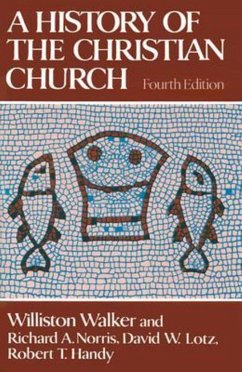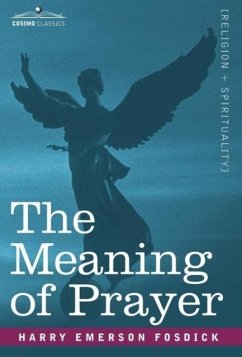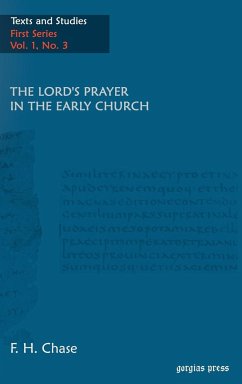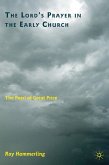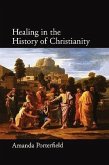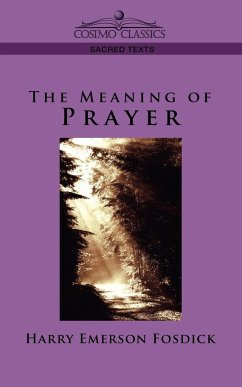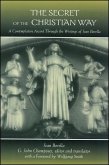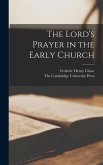Williston Walker
History of the Christian Church
Schade – dieser Artikel ist leider ausverkauft. Sobald wir wissen, ob und wann der Artikel wieder verfügbar ist, informieren wir Sie an dieser Stelle.
Williston Walker
History of the Christian Church
- Gebundenes Buch
- Merkliste
- Auf die Merkliste
- Bewerten Bewerten
- Teilen
- Produkt teilen
- Produkterinnerung
- Produkterinnerung
Since publication of the first edition in 1918, A History of the Christian Church has enjoyed success and recognition as a classic in the field. Written by an eminent theologian, it combines in its narrative a rare blend of clarity, unity, and balance.
Andere Kunden interessierten sich auch für
![The Meaning of Prayer The Meaning of Prayer]() Harry Emerson FosdickThe Meaning of Prayer30,99 €
Harry Emerson FosdickThe Meaning of Prayer30,99 €![The Lord's Prayer in the Early Church The Lord's Prayer in the Early Church]() Frederic Henry ChaseThe Lord's Prayer in the Early Church106,99 €
Frederic Henry ChaseThe Lord's Prayer in the Early Church106,99 €![The Lord's Prayer in the Early Church The Lord's Prayer in the Early Church]() R. HammerlingThe Lord's Prayer in the Early Church97,99 €
R. HammerlingThe Lord's Prayer in the Early Church97,99 €![Healing in the History of Christianity Healing in the History of Christianity]() Amanda PorterfieldHealing in the History of Christianity33,99 €
Amanda PorterfieldHealing in the History of Christianity33,99 €![The Meaning of Prayer The Meaning of Prayer]() Harry Emerson FosdickThe Meaning of Prayer20,99 €
Harry Emerson FosdickThe Meaning of Prayer20,99 €![The Secret of the Christian Way The Secret of the Christian Way]() Jean BorellaThe Secret of the Christian Way103,99 €
Jean BorellaThe Secret of the Christian Way103,99 €![The Lord's Prayer in the Early Church The Lord's Prayer in the Early Church]() Frederic Henry ChaseThe Lord's Prayer in the Early Church33,99 €
Frederic Henry ChaseThe Lord's Prayer in the Early Church33,99 €-
-
Since publication of the first edition in 1918, A History of the Christian Church has enjoyed success and recognition as a classic in the field. Written by an eminent theologian, it combines in its narrative a rare blend of clarity, unity, and balance.
Produktdetails
- Produktdetails
- Verlag: Scribner Book Company
- 4th edition
- Seitenzahl: 768
- Erscheinungstermin: 1. Mai 1985
- Englisch
- Abmessung: 239mm x 165mm x 43mm
- Gewicht: 1111g
- ISBN-13: 9780684184173
- ISBN-10: 0684184176
- Artikelnr.: 22104080
- Herstellerkennzeichnung
- Libri GmbH
- Europaallee 1
- 36244 Bad Hersfeld
- gpsr@libri.de
- Verlag: Scribner Book Company
- 4th edition
- Seitenzahl: 768
- Erscheinungstermin: 1. Mai 1985
- Englisch
- Abmessung: 239mm x 165mm x 43mm
- Gewicht: 1111g
- ISBN-13: 9780684184173
- ISBN-10: 0684184176
- Artikelnr.: 22104080
- Herstellerkennzeichnung
- Libri GmbH
- Europaallee 1
- 36244 Bad Hersfeld
- gpsr@libri.de
Williston Walker was born in Portland, Maine, July 1, 1860, the son of a distinguished Congregational minister. He received his A. B. degree from Amherst College in 1883, was graduated from Hartford Theological Seminary in 1886 and received his Ph.D. degree from the University of Leipzig in 1888. He succeeded Woodrow Wilson as associate professor of history at Bryn Mawr College. He later taught church history at Hartford Theological Seminary. In 1901 Yale University called him to succeed George Park Fisher as Titus Street Professor of Ecclesiastical History, a position which he held until his death in 1922. The Reformation, Ten New England Leaders, Great Men of the Christian Church, and A History of the Christian Church are among his distinguished works.
Contents
PREFACE
PREFACE TO THE THIRD EDITION
REVISERS' PREFACE
Period I
FROM THE BEGINNINGS TO THE GNOSTIC CRISIS
1 The General Situation
2 The Jewish Background
3 Jesus and the Disciples
4 The Early Christian Community
5 Paul and Gentile Christianity
6 The Close of the Apostolic Age
7 The Interpretation of Jesus
8 Gentile Christianity of the Second Century
9 Christian Organization
10 Christianity and the Roman Government
11 The Apologists
Period II
FROM THE GNOSTIC CRISIS TO CONSTANTINE
1 Gnosticism
2 Marcion
3 Montanism
4 The Catholic Church
5 The Growing Importance of the Roman Church
6 lrenaeus of Lyon
7 Tertullian and Cyprian
8 The Logos Theology and Monarchianism
9 The Alexandrian School
10 Church and Roman Society from 180 to 260
11 The Constitutional Development of the Church
12 Public Worship and Sacred Time
13 Baptism
14 The Eucharist
15 Forgiveness of Sins
16 Patterns of Christian Life
17 Rest and Growth
18 Rival Religious Forces
19 The Final Struggle
Period III
THE IMPERIAL STATE CHURCH
1 The Changed Situation
2 The Arian Controversy to the Death of Constantine
3 Controversy under Constantine's Sons
4 The Later Nicene Struggle
5 The Germanic Invasions
6 The Growth of the Papacy
7 Monasticism
8 Ambrose and Chrysostom
9 The Christological Controversies
10 The East Divided
11 Controversy and Catastrophe in the East
12 The Constitutional Development o! the Church
13 Worship and Piety
14 The Latin Christian Tradition
15 Jerome
16 Augustine of Hippo
17 The Pelagian Controversy
18 Semi-Pelagianism
19 Gregory the Great
Period IV
THE MIDDLE AGES TO THE CLOSE OF THE INVESTITURE CONTROVERSY
1 Missions in the British Isles
2 Christianity and the Frankish Kingdom
S East and West in the Iconoclastic Controversy
4 The Franks and the Papacy
5 Charles the Great
6 European Christianity in the Ninth Century
7 The Papacy and the Ottonian Empire
8 The Greek Church after the Iconoclastic Controversy
9 Christian Expansion in the Early Middle Ages
10 The Reforming Papacy
11 From Reform to Revolution
12 Hildebrand and Henry IV
13 The End of the Investiture Struggle
Period V
THE LATER MIDDLE AGES
1 The Crusades
2 New Religious Movements
3 Medieval Heresy -- The Cathars and Waldenses; the Inquisition
4 The Dominicans, Franciscans, and Other Mendicant Orders
5 Early Scholasticism; Anselm of Canterbury and Peter Abelard
6 The Rediscovery of Aristotle; the Rise of the Universities
7 High Scholasticism and Its Theology; Thomas Aquinas
8 Late Scholasticism; Duns Scotus and William of Ockham
9 Mysticism, the Modern Devotion, and Heresy
10 Missions and Defeats
11 The Papacy at Its Height and Its Decline
12 The Avignon Papacy; Papal Critics and Defenders; the Great Schism
13 Wyclif and Hus
14 The Reforming Councils
15 The Italian Renaissance and Its Popes; Popular Religious Leaders
16 The New National Powers
17 Humanism North of the Alps; Piety on the Eve of the Reformation
Period VI
THE REFORMATION
1 Luther's Development and the Beginnings of the Reformation
2 Separations and Divisions
3 Ulrich Zwingli and the Swiss Reformation
4 The Anabaptists
5 German Protestantism Established
6 The Scandinavian Lands
7 The Reformation in French Switzerland and Geneva before Calvin
8 John Calvin
9 The English Reformation
10 The Scottish Reformation
11 The Catholic Reformation and Counter-Reformation
12 Confessional Strife in France, the Netherlands, and England
13 German Religious Controversies and the Thirty Years' War
14 Socinianism
15 Arminianism
16 Anglicanism, Puritanism, and the Free Churches in England, Episcopacy
and Presbyterianism in Scotland
17 The Quakers
Period VII
MODERN CHRISTIANITY
1 The Beginnings of Modern Science and Philosophy
2 The Transplantation of Christianity to the Americas
3 Deism and Its Opponents; Skepticism
4 Unitarianism in England and America
5 Pietism in Germany
6 Zinzendorf and Moravianism
7 The Evangelical Revival in Great Britain; Wesley and Methodism
8 The Great Awakening
9 The Impact of the Evangelical Revival; the Rise of Modern Missions
10 The Revolutionary Epoch in the United States
11 The German Enlightenment (Aufklärung)
12 Trends in Nineteenth-Century Protestant Thought in Germany
13 British Protestantism in the Nineteenth Century
14 Continental Protestantism in the Nineteenth Century
15 American Protestantism in the Nineteenth Century
16 Roman Catholicism in the Modern World
17 The Eastern Churches in Modern Times
18 The Growth of the Ecumenical Movement
19 The Church in the World
BIBLIOGRAPHICAL SUGGESTIONS
INDEX
Maps and Charts
The Roman Empire around the Time of Hadrian
Europe at the End o! the Fifth Century
The Empire of Charles the Great
The Byzantine Empire and the Crusader States (First Crusade)
Europe about 1500
arReligious Divisions in Europe about 1600
Approximate Distribution of Churches in Colonial America, 1775-1776
Spread of Church Colleges in America up to 1860
Major Ecumenical Gatherings
PREFACE
PREFACE TO THE THIRD EDITION
REVISERS' PREFACE
Period I
FROM THE BEGINNINGS TO THE GNOSTIC CRISIS
1 The General Situation
2 The Jewish Background
3 Jesus and the Disciples
4 The Early Christian Community
5 Paul and Gentile Christianity
6 The Close of the Apostolic Age
7 The Interpretation of Jesus
8 Gentile Christianity of the Second Century
9 Christian Organization
10 Christianity and the Roman Government
11 The Apologists
Period II
FROM THE GNOSTIC CRISIS TO CONSTANTINE
1 Gnosticism
2 Marcion
3 Montanism
4 The Catholic Church
5 The Growing Importance of the Roman Church
6 lrenaeus of Lyon
7 Tertullian and Cyprian
8 The Logos Theology and Monarchianism
9 The Alexandrian School
10 Church and Roman Society from 180 to 260
11 The Constitutional Development of the Church
12 Public Worship and Sacred Time
13 Baptism
14 The Eucharist
15 Forgiveness of Sins
16 Patterns of Christian Life
17 Rest and Growth
18 Rival Religious Forces
19 The Final Struggle
Period III
THE IMPERIAL STATE CHURCH
1 The Changed Situation
2 The Arian Controversy to the Death of Constantine
3 Controversy under Constantine's Sons
4 The Later Nicene Struggle
5 The Germanic Invasions
6 The Growth of the Papacy
7 Monasticism
8 Ambrose and Chrysostom
9 The Christological Controversies
10 The East Divided
11 Controversy and Catastrophe in the East
12 The Constitutional Development o! the Church
13 Worship and Piety
14 The Latin Christian Tradition
15 Jerome
16 Augustine of Hippo
17 The Pelagian Controversy
18 Semi-Pelagianism
19 Gregory the Great
Period IV
THE MIDDLE AGES TO THE CLOSE OF THE INVESTITURE CONTROVERSY
1 Missions in the British Isles
2 Christianity and the Frankish Kingdom
S East and West in the Iconoclastic Controversy
4 The Franks and the Papacy
5 Charles the Great
6 European Christianity in the Ninth Century
7 The Papacy and the Ottonian Empire
8 The Greek Church after the Iconoclastic Controversy
9 Christian Expansion in the Early Middle Ages
10 The Reforming Papacy
11 From Reform to Revolution
12 Hildebrand and Henry IV
13 The End of the Investiture Struggle
Period V
THE LATER MIDDLE AGES
1 The Crusades
2 New Religious Movements
3 Medieval Heresy -- The Cathars and Waldenses; the Inquisition
4 The Dominicans, Franciscans, and Other Mendicant Orders
5 Early Scholasticism; Anselm of Canterbury and Peter Abelard
6 The Rediscovery of Aristotle; the Rise of the Universities
7 High Scholasticism and Its Theology; Thomas Aquinas
8 Late Scholasticism; Duns Scotus and William of Ockham
9 Mysticism, the Modern Devotion, and Heresy
10 Missions and Defeats
11 The Papacy at Its Height and Its Decline
12 The Avignon Papacy; Papal Critics and Defenders; the Great Schism
13 Wyclif and Hus
14 The Reforming Councils
15 The Italian Renaissance and Its Popes; Popular Religious Leaders
16 The New National Powers
17 Humanism North of the Alps; Piety on the Eve of the Reformation
Period VI
THE REFORMATION
1 Luther's Development and the Beginnings of the Reformation
2 Separations and Divisions
3 Ulrich Zwingli and the Swiss Reformation
4 The Anabaptists
5 German Protestantism Established
6 The Scandinavian Lands
7 The Reformation in French Switzerland and Geneva before Calvin
8 John Calvin
9 The English Reformation
10 The Scottish Reformation
11 The Catholic Reformation and Counter-Reformation
12 Confessional Strife in France, the Netherlands, and England
13 German Religious Controversies and the Thirty Years' War
14 Socinianism
15 Arminianism
16 Anglicanism, Puritanism, and the Free Churches in England, Episcopacy
and Presbyterianism in Scotland
17 The Quakers
Period VII
MODERN CHRISTIANITY
1 The Beginnings of Modern Science and Philosophy
2 The Transplantation of Christianity to the Americas
3 Deism and Its Opponents; Skepticism
4 Unitarianism in England and America
5 Pietism in Germany
6 Zinzendorf and Moravianism
7 The Evangelical Revival in Great Britain; Wesley and Methodism
8 The Great Awakening
9 The Impact of the Evangelical Revival; the Rise of Modern Missions
10 The Revolutionary Epoch in the United States
11 The German Enlightenment (Aufklärung)
12 Trends in Nineteenth-Century Protestant Thought in Germany
13 British Protestantism in the Nineteenth Century
14 Continental Protestantism in the Nineteenth Century
15 American Protestantism in the Nineteenth Century
16 Roman Catholicism in the Modern World
17 The Eastern Churches in Modern Times
18 The Growth of the Ecumenical Movement
19 The Church in the World
BIBLIOGRAPHICAL SUGGESTIONS
INDEX
Maps and Charts
The Roman Empire around the Time of Hadrian
Europe at the End o! the Fifth Century
The Empire of Charles the Great
The Byzantine Empire and the Crusader States (First Crusade)
Europe about 1500
arReligious Divisions in Europe about 1600
Approximate Distribution of Churches in Colonial America, 1775-1776
Spread of Church Colleges in America up to 1860
Major Ecumenical Gatherings
Contents
PREFACE
PREFACE TO THE THIRD EDITION
REVISERS' PREFACE
Period I
FROM THE BEGINNINGS TO THE GNOSTIC CRISIS
1 The General Situation
2 The Jewish Background
3 Jesus and the Disciples
4 The Early Christian Community
5 Paul and Gentile Christianity
6 The Close of the Apostolic Age
7 The Interpretation of Jesus
8 Gentile Christianity of the Second Century
9 Christian Organization
10 Christianity and the Roman Government
11 The Apologists
Period II
FROM THE GNOSTIC CRISIS TO CONSTANTINE
1 Gnosticism
2 Marcion
3 Montanism
4 The Catholic Church
5 The Growing Importance of the Roman Church
6 lrenaeus of Lyon
7 Tertullian and Cyprian
8 The Logos Theology and Monarchianism
9 The Alexandrian School
10 Church and Roman Society from 180 to 260
11 The Constitutional Development of the Church
12 Public Worship and Sacred Time
13 Baptism
14 The Eucharist
15 Forgiveness of Sins
16 Patterns of Christian Life
17 Rest and Growth
18 Rival Religious Forces
19 The Final Struggle
Period III
THE IMPERIAL STATE CHURCH
1 The Changed Situation
2 The Arian Controversy to the Death of Constantine
3 Controversy under Constantine's Sons
4 The Later Nicene Struggle
5 The Germanic Invasions
6 The Growth of the Papacy
7 Monasticism
8 Ambrose and Chrysostom
9 The Christological Controversies
10 The East Divided
11 Controversy and Catastrophe in the East
12 The Constitutional Development o! the Church
13 Worship and Piety
14 The Latin Christian Tradition
15 Jerome
16 Augustine of Hippo
17 The Pelagian Controversy
18 Semi-Pelagianism
19 Gregory the Great
Period IV
THE MIDDLE AGES TO THE CLOSE OF THE INVESTITURE CONTROVERSY
1 Missions in the British Isles
2 Christianity and the Frankish Kingdom
S East and West in the Iconoclastic Controversy
4 The Franks and the Papacy
5 Charles the Great
6 European Christianity in the Ninth Century
7 The Papacy and the Ottonian Empire
8 The Greek Church after the Iconoclastic Controversy
9 Christian Expansion in the Early Middle Ages
10 The Reforming Papacy
11 From Reform to Revolution
12 Hildebrand and Henry IV
13 The End of the Investiture Struggle
Period V
THE LATER MIDDLE AGES
1 The Crusades
2 New Religious Movements
3 Medieval Heresy -- The Cathars and Waldenses; the Inquisition
4 The Dominicans, Franciscans, and Other Mendicant Orders
5 Early Scholasticism; Anselm of Canterbury and Peter Abelard
6 The Rediscovery of Aristotle; the Rise of the Universities
7 High Scholasticism and Its Theology; Thomas Aquinas
8 Late Scholasticism; Duns Scotus and William of Ockham
9 Mysticism, the Modern Devotion, and Heresy
10 Missions and Defeats
11 The Papacy at Its Height and Its Decline
12 The Avignon Papacy; Papal Critics and Defenders; the Great Schism
13 Wyclif and Hus
14 The Reforming Councils
15 The Italian Renaissance and Its Popes; Popular Religious Leaders
16 The New National Powers
17 Humanism North of the Alps; Piety on the Eve of the Reformation
Period VI
THE REFORMATION
1 Luther's Development and the Beginnings of the Reformation
2 Separations and Divisions
3 Ulrich Zwingli and the Swiss Reformation
4 The Anabaptists
5 German Protestantism Established
6 The Scandinavian Lands
7 The Reformation in French Switzerland and Geneva before Calvin
8 John Calvin
9 The English Reformation
10 The Scottish Reformation
11 The Catholic Reformation and Counter-Reformation
12 Confessional Strife in France, the Netherlands, and England
13 German Religious Controversies and the Thirty Years' War
14 Socinianism
15 Arminianism
16 Anglicanism, Puritanism, and the Free Churches in England, Episcopacy
and Presbyterianism in Scotland
17 The Quakers
Period VII
MODERN CHRISTIANITY
1 The Beginnings of Modern Science and Philosophy
2 The Transplantation of Christianity to the Americas
3 Deism and Its Opponents; Skepticism
4 Unitarianism in England and America
5 Pietism in Germany
6 Zinzendorf and Moravianism
7 The Evangelical Revival in Great Britain; Wesley and Methodism
8 The Great Awakening
9 The Impact of the Evangelical Revival; the Rise of Modern Missions
10 The Revolutionary Epoch in the United States
11 The German Enlightenment (Aufklärung)
12 Trends in Nineteenth-Century Protestant Thought in Germany
13 British Protestantism in the Nineteenth Century
14 Continental Protestantism in the Nineteenth Century
15 American Protestantism in the Nineteenth Century
16 Roman Catholicism in the Modern World
17 The Eastern Churches in Modern Times
18 The Growth of the Ecumenical Movement
19 The Church in the World
BIBLIOGRAPHICAL SUGGESTIONS
INDEX
Maps and Charts
The Roman Empire around the Time of Hadrian
Europe at the End o! the Fifth Century
The Empire of Charles the Great
The Byzantine Empire and the Crusader States (First Crusade)
Europe about 1500
arReligious Divisions in Europe about 1600
Approximate Distribution of Churches in Colonial America, 1775-1776
Spread of Church Colleges in America up to 1860
Major Ecumenical Gatherings
PREFACE
PREFACE TO THE THIRD EDITION
REVISERS' PREFACE
Period I
FROM THE BEGINNINGS TO THE GNOSTIC CRISIS
1 The General Situation
2 The Jewish Background
3 Jesus and the Disciples
4 The Early Christian Community
5 Paul and Gentile Christianity
6 The Close of the Apostolic Age
7 The Interpretation of Jesus
8 Gentile Christianity of the Second Century
9 Christian Organization
10 Christianity and the Roman Government
11 The Apologists
Period II
FROM THE GNOSTIC CRISIS TO CONSTANTINE
1 Gnosticism
2 Marcion
3 Montanism
4 The Catholic Church
5 The Growing Importance of the Roman Church
6 lrenaeus of Lyon
7 Tertullian and Cyprian
8 The Logos Theology and Monarchianism
9 The Alexandrian School
10 Church and Roman Society from 180 to 260
11 The Constitutional Development of the Church
12 Public Worship and Sacred Time
13 Baptism
14 The Eucharist
15 Forgiveness of Sins
16 Patterns of Christian Life
17 Rest and Growth
18 Rival Religious Forces
19 The Final Struggle
Period III
THE IMPERIAL STATE CHURCH
1 The Changed Situation
2 The Arian Controversy to the Death of Constantine
3 Controversy under Constantine's Sons
4 The Later Nicene Struggle
5 The Germanic Invasions
6 The Growth of the Papacy
7 Monasticism
8 Ambrose and Chrysostom
9 The Christological Controversies
10 The East Divided
11 Controversy and Catastrophe in the East
12 The Constitutional Development o! the Church
13 Worship and Piety
14 The Latin Christian Tradition
15 Jerome
16 Augustine of Hippo
17 The Pelagian Controversy
18 Semi-Pelagianism
19 Gregory the Great
Period IV
THE MIDDLE AGES TO THE CLOSE OF THE INVESTITURE CONTROVERSY
1 Missions in the British Isles
2 Christianity and the Frankish Kingdom
S East and West in the Iconoclastic Controversy
4 The Franks and the Papacy
5 Charles the Great
6 European Christianity in the Ninth Century
7 The Papacy and the Ottonian Empire
8 The Greek Church after the Iconoclastic Controversy
9 Christian Expansion in the Early Middle Ages
10 The Reforming Papacy
11 From Reform to Revolution
12 Hildebrand and Henry IV
13 The End of the Investiture Struggle
Period V
THE LATER MIDDLE AGES
1 The Crusades
2 New Religious Movements
3 Medieval Heresy -- The Cathars and Waldenses; the Inquisition
4 The Dominicans, Franciscans, and Other Mendicant Orders
5 Early Scholasticism; Anselm of Canterbury and Peter Abelard
6 The Rediscovery of Aristotle; the Rise of the Universities
7 High Scholasticism and Its Theology; Thomas Aquinas
8 Late Scholasticism; Duns Scotus and William of Ockham
9 Mysticism, the Modern Devotion, and Heresy
10 Missions and Defeats
11 The Papacy at Its Height and Its Decline
12 The Avignon Papacy; Papal Critics and Defenders; the Great Schism
13 Wyclif and Hus
14 The Reforming Councils
15 The Italian Renaissance and Its Popes; Popular Religious Leaders
16 The New National Powers
17 Humanism North of the Alps; Piety on the Eve of the Reformation
Period VI
THE REFORMATION
1 Luther's Development and the Beginnings of the Reformation
2 Separations and Divisions
3 Ulrich Zwingli and the Swiss Reformation
4 The Anabaptists
5 German Protestantism Established
6 The Scandinavian Lands
7 The Reformation in French Switzerland and Geneva before Calvin
8 John Calvin
9 The English Reformation
10 The Scottish Reformation
11 The Catholic Reformation and Counter-Reformation
12 Confessional Strife in France, the Netherlands, and England
13 German Religious Controversies and the Thirty Years' War
14 Socinianism
15 Arminianism
16 Anglicanism, Puritanism, and the Free Churches in England, Episcopacy
and Presbyterianism in Scotland
17 The Quakers
Period VII
MODERN CHRISTIANITY
1 The Beginnings of Modern Science and Philosophy
2 The Transplantation of Christianity to the Americas
3 Deism and Its Opponents; Skepticism
4 Unitarianism in England and America
5 Pietism in Germany
6 Zinzendorf and Moravianism
7 The Evangelical Revival in Great Britain; Wesley and Methodism
8 The Great Awakening
9 The Impact of the Evangelical Revival; the Rise of Modern Missions
10 The Revolutionary Epoch in the United States
11 The German Enlightenment (Aufklärung)
12 Trends in Nineteenth-Century Protestant Thought in Germany
13 British Protestantism in the Nineteenth Century
14 Continental Protestantism in the Nineteenth Century
15 American Protestantism in the Nineteenth Century
16 Roman Catholicism in the Modern World
17 The Eastern Churches in Modern Times
18 The Growth of the Ecumenical Movement
19 The Church in the World
BIBLIOGRAPHICAL SUGGESTIONS
INDEX
Maps and Charts
The Roman Empire around the Time of Hadrian
Europe at the End o! the Fifth Century
The Empire of Charles the Great
The Byzantine Empire and the Crusader States (First Crusade)
Europe about 1500
arReligious Divisions in Europe about 1600
Approximate Distribution of Churches in Colonial America, 1775-1776
Spread of Church Colleges in America up to 1860
Major Ecumenical Gatherings

